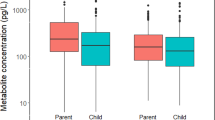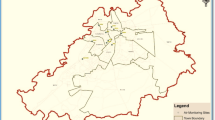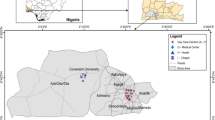Abstract
Assessment of the health risks resulting from exposure to ambient polycyclic aromatic hydrocarbons (PAH) is limited by a lack of environmental exposure data among the general population. This study characterized personal exposure and ambient concentrations of PAH in the Village of Waterfront South (WFS), an urban community with many mixed sources of air toxics in Camden, New Jersey, and CopeWood/Davis Streets (CDS), an urban reference area located ∼1 mile east of WFS. A total of 54 and 53 participants were recruited from non-smoking households in WFS and CDS, respectively. In all, 24-h personal and ambient air samples were collected simultaneously in both areas on weekdays and weekends during summer and winter. The ambient PAH concentrations in WFS were either significantly higher than or comparable to those in CDS, indicating the significant impact of local sources on PAH pollution in WFS. Analysis of diagnostic ratios and correlation suggested that diesel truck traffic, municipal waste combustion and industrial combustion were the major sources in WFS. In such an area, ambient air pollution contributed significantly to personal PAH exposure, explaining 44–96% of variability in personal concentrations. This study provides valuable data for examining the impact of local ambient PAH pollution on personal exposure and therefore potential health risks associated with environmental PAH pollution.
This is a preview of subscription content, access via your institution
Access options
Subscribe to this journal
Receive 6 print issues and online access
$259.00 per year
only $43.17 per issue
Buy this article
- Purchase on Springer Link
- Instant access to full article PDF
Prices may be subject to local taxes which are calculated during checkout


Similar content being viewed by others
References
Armstrong B.G., Tremblay C.G., Cyr D., and Thériault G.P. Estimating the relationship between exposure to tar volatiles and the incidence of bladder cancer in aluminum smelter workers. Scand J Work Environ Health 1986: 12: 486–493.
ATSDR (Agency for Toxic Substances and Disease Registry). Toxicological Profile for Polycyclic Aromatic Hydrocarbons. U.S. Department of Health and Human Services, Atlanta, GA, 1995.
Baek S.O., Field R.A., Goldstone M.E., Kirk P.W., Lester J.N., and Perry R. A review of atmospheric polycyclic aromatic hydrocarbons: sources, fate and behavior. Water Air Soil Pollution 1991: 60: 279–300.
Buckley T.J., Waldman J.M., Dhara R., Greenberg A., Ouyang Z., and Lioy P.J. An assessment of a urinary biomarker for total human environmental exposure to benzo[a]pyrene. Int Arch Occup Environ Health 1995: 67: 257–266.
Choi H., Perera F., Pac A., Wang L., Flak E., and Mroz E., et al. Estimating individual-level exposure to airborne polycyclic aromatic hydrocarbons throughout the gestational period based on personal, indoor, and outdoor monitoring. Environ Health Perspect 2008: 116: 1509–1518.
Chuang J.C., Callahan P.J., Lyu C.W., and Wilson N.K. Polycyclic aromatic hydrocarbon exposures of children in low-income families. J Expo Anal Environ Epidemiol 1999: 9: 85–98.
Dickhut R.M., Canuel E.A., Gustafson K.E., Liu K., Arzayus K.M., and Walker S.E., et al. Automotive sources of carcinogenic polycyclic aromatic hydrocarbons associated with particulate matter in the Chesapeake Bay region. Environ Sci Technol 2000: 34: 4635–4640.
Eisenreich S.J, Brunciak P.A, Gigliotti C, Totten L, Nelson E.D ., and Dachs J., et al. The Atmosphere as a Source and Sink of PCBs and PAHs in the NY-NJ Harbor Estuary. NJ DEP, Trenton, NJ, 2001.
Fan Z., Jung K.H., and Lioy P.J. Development of a passive sampler to measure personal exposure to gaseous PAHs in community settings. Environ Sci Technol 2006: 40: 6051–6057.
Fiala Z., Vyskocil A., Krajak V., Viau C., Ettlerova E., and Bukac J., et al. Environmental exposure of small children to polycyclic aromatic hydrocarbons. Int Arch Occup Environ Health 2001: 74: 411–420.
Fraser M.P., Cass G.R., Simoneit B.R.T., and Rasmussen R.A. Air quality model evaluation data for organics. 5. C6-C22 nonpolar and semipolar aromatic compounds. Environ Sci Technol 1998: 32: 1760–1770.
Fromme H., Lahrz T., Piloty M., Gebhardt H., Oddoy A., and Rüden H. Polycyclic aromatic hydrocarbons inside and outside of apartments in an urban area. Sci Total Environ 2004: 326: 143–149.
Georgiadis P., Stoikidou M., Topinka J., Kaila S., Gioka M., and Katsouyanni K., et al. Personal exposures to PM2.5 and polycyclic aromatic hydrocarbons and their relationship to environmental tobacco smoke at two locations in Greece. J Expo Anal Environ Epidemiol 2001: 11: 169–183.
Gogou A., Stratigakis N., Kanakidou M., and Stephanou E. Organic aerosols in eastern Mediterranean: components source reconciliation by using molecular markers and atmospheric back trajectories. Organic Geochem 1996: 25: 79–96.
Hong H., Yin H., Wang X., and Ye C. Seasonal variation of PM10-bound PAHs in the atmosphere of Xiamen, China. Atmospheric Res 2007: 85: 429–441.
IARC (International Agency for Research on Cancer). Evaluation of the carcinogenic risk of chemicals to humans: overall evaluations of carcinogenicity. IARC Monogr Carc Risk Chem Hum 1987: (Suppl. 7): 40–74.
Kim D., and Young T.M. Significance of indirect deposition on wintertime PAH concentrations in an urban Northern California Creek. Environ Engineering Sci 2009: 26: 269–277.
Li C.K., and Kamens R.M. The use of polycyclic aromatic hydrocarbons as source signatures in receptor modeling. Atmospheric Environ Part A-General Topics 1993: 27: 523–532.
Lioy P.L., Waldman J.M., Greenberg A., Harkov R., and Pietarinen C. The Total Human Environmental Exposure Study (THEES) to benzo(a)pyrene: comparison of the inhalation and food pathways. Arch Environ Health 1988: 43: 304–312.
Mitra S., and Ray B. Patterns and sources of polycyclic aromatic hydrocarbons and their derivatives in indoor air. Atmospheric Environ 1995: 29: 3345–3356.
Motelay-Massei A., Ollivon D., Garban B., Tiphagne-Larcher K., Zimmerlin I., and Chevreuil M. PAHs in the bulk atmospheric deposition of the Seine river basin: source identification and apportionment by ratios, multivariate statistical techniques and scanning electron microscopy. Chemosphere 2007: 67: 312–321.
Muendo M., Hanai Y., Kameda Y., and Masunaga S. Polycyclic aromatic hydrocarbons in urban air: concentration levels, patterns, and source analysis in Nairobi, Kenya. Environ Forensics 2006: 7: 147–157.
Nammari D.R., Hogland W., Marques M., Nimmermark S., and Moutavtchi V. Emissions from a controlled fire in municipal solid waste bales. Waste Manage 2004: 24: 9–18.
Naumova Y.Y., Eisenreich S.J., Turpin B.J., Weisel C.P., Morandi M.T., and Colome S.D., et al. Polycyclic aromatic hydrocarbons in the indoor and outdoor air of three cities in the U.S. Environ Sci Technol 2002: 36: 2552–2559.
New Jersey Department of Environmental Protection (NJDEP). Camden Waterfront South Air Toxics Pilot Project-Final Report. Trenton, NJ, 2005.
New Jersey Department of Transportation (NJDOT). Roadway Information and Traffic Counts. http://www.state.nj.us/transportation/refdata/roadway/traffic.shtm, 2006.
Ohura T., Noda T., Amagai T., and Fusaya M. Prediction of personal exposure to PM2.5 and carcinogenic polycyclic aromatic hydrocarbons by their concentrations in residential microenvironments. Environ Sci Technol 2005: 39: 5592–5599.
Park J.-S., Wade T.L., and Sweet S. Atmospheric distribution of polycyclic aromatic hydrocarbons and deposition to Galveston Bay, Texas, USA. Atmospheric Environ 2001: 35: 3241–3249.
Saborit J.M.D., Aquilina N.J., Meddings C., Baker S., Vardoulakis S., and Harrison R.M. Measurement of personal exposure to volatile organic compounds and particle associated PAH in three UK regions. Environ Sci Technol 2009: 43: 4582–4588.
Sicre M.A., Marty J.C., Saliot A., Aparicio X., Grilmat J., and Albaiges J. Aliphatic and aromatic hydrocarbons in different sized aerosols over the Mediterranean Sea: occurrence and origin. Atmospheric Environ 1987: 21: 2247–2259.
Sisovic A., Fugas M., and Sega K. Assessment of human inhalation exposure to polycyclic aromatic hydrocarbons. J Expo Anal Environ Epidemiol 1996: 6: 439–447.
Steineck G., Plato N., Alfredsson L., and Norell S.E. Industry-related urothelial carcinogens: application of a job-exposure matrix to census data. Am J Ind Med 1989: 16: 209–224.
Tonne C.C., Whyatt R.M., Camann D.E., Perera F.P., and Kinney P.L. Predictors of personal polycyclic aromatic hydrocarbon exposures among pregnant minority women in New York City. Environ Health Perspect 2004: 112: 754–759.
U.S. Census Bureau. http://www.census.gov, 2000.
Waldman J.M., Lioy P.L., Greenberg A., and Butler J.P. Analysis of human exposure to benzo[a]pyrene via inhalation and food ingestion in the Total Human Environmental Exposure Study (THEES). J Expo Anal Environ Epidemiol 1991: 1: 193–225.
Wu X., Fan Z., and Ohman-Strickland P. Time-location patterns of a population living in an air pollution hotspot. J Environ Public Health 2010: 2010: 1–10.
Zmirou D., Masclet P., Boudet C., Dor F., and Déchenaux J. Personal exposure to atmospheric polycyclic aromatic hydrocarbons in a general adult population and lung cancer risk assessment. J Occup Environ Med 2000: 42: 121–126.
Zhu X., Fan Z., Wu X., Meng Q., Wang S.-W., and Tang X., et al. Spatial variation of volatile organic compounds in a “Hot Spot” for air pollution. Atmospheric Environ 2008: 42: 7329–7338.
Acknowledgements
This study was supported by the Health Effects Institute (HEI Agreement Number: 4703-RFA03-1/03-15). Drs. Fan and Lioy are also supported in part by the NIEHS sponsored UMDNJ Center for Environmental Exposures and Disease, Grant No. NIEHS P30ES005022. The views expressed in this paper are those of the authors and do not necessarily reflect the views or policies of the funding agencies. The authors thank all the participants for their cooperation.
Author information
Authors and Affiliations
Corresponding author
Ethics declarations
Competing interests
The authors declare no conflict of interest.
Rights and permissions
About this article
Cite this article
Zhu, X., Fan, Z., Wu, X. et al. Ambient concentrations and personal exposure to polycyclic aromatic hydrocarbons (PAH) in an urban community with mixed sources of air pollution. J Expo Sci Environ Epidemiol 21, 437–449 (2011). https://doi.org/10.1038/jes.2011.2
Received:
Accepted:
Published:
Issue Date:
DOI: https://doi.org/10.1038/jes.2011.2
Keywords
This article is cited by
-
Indoor exposure to phthalates and polycyclic aromatic hydrocarbons (PAHs) to Canadian children: the Kingston allergy birth cohort
Journal of Exposure Science & Environmental Epidemiology (2022)
-
Mutagenic and DNA repair activity in traffic policemen: a case-crossover study
Journal of Occupational Medicine and Toxicology (2018)
-
Preparation and performance features of wristband samplers and considerations for chemical exposure assessment
Journal of Exposure Science & Environmental Epidemiology (2017)
-
Comparison of trace elements in size-fractionated particles in two communities with contrasting socioeconomic status in Houston, TX
Environmental Monitoring and Assessment (2017)
-
Characterization of a protocatechuate catabolic gene cluster in Rhodococcus ruber OA1 involved in naphthalene degradation
Annals of Microbiology (2016)



